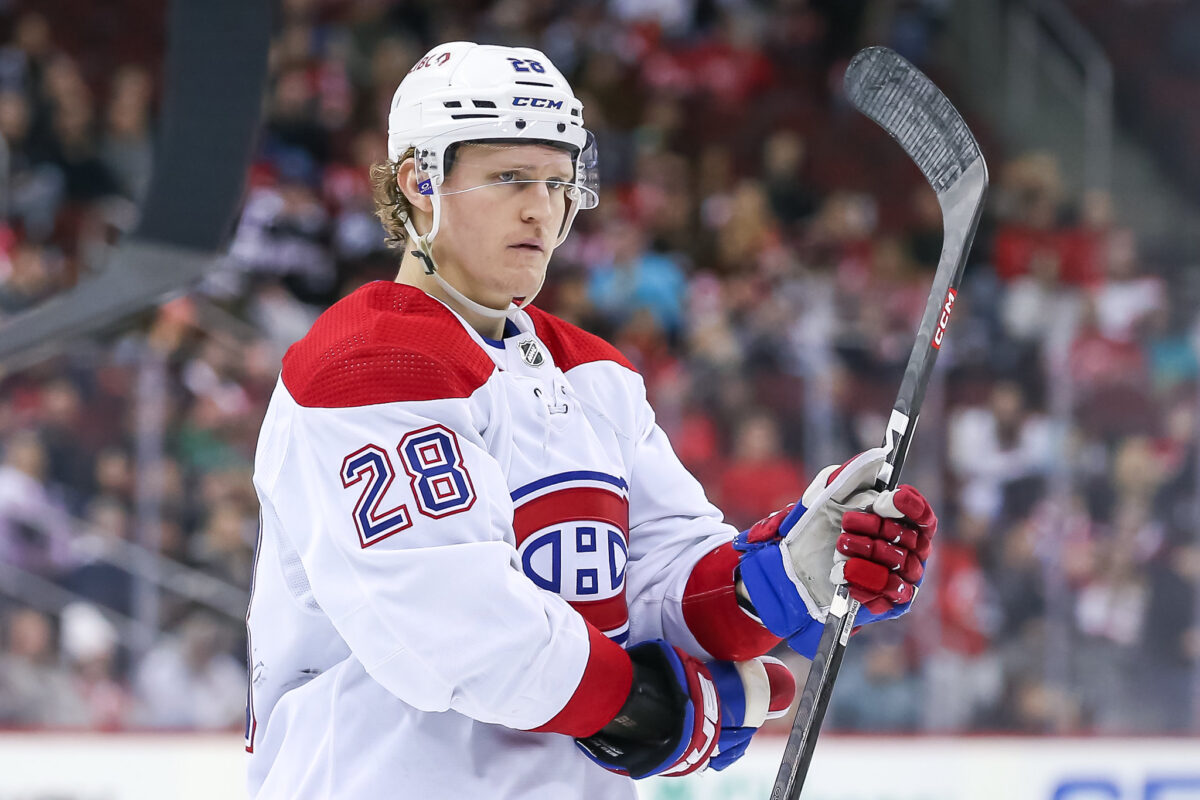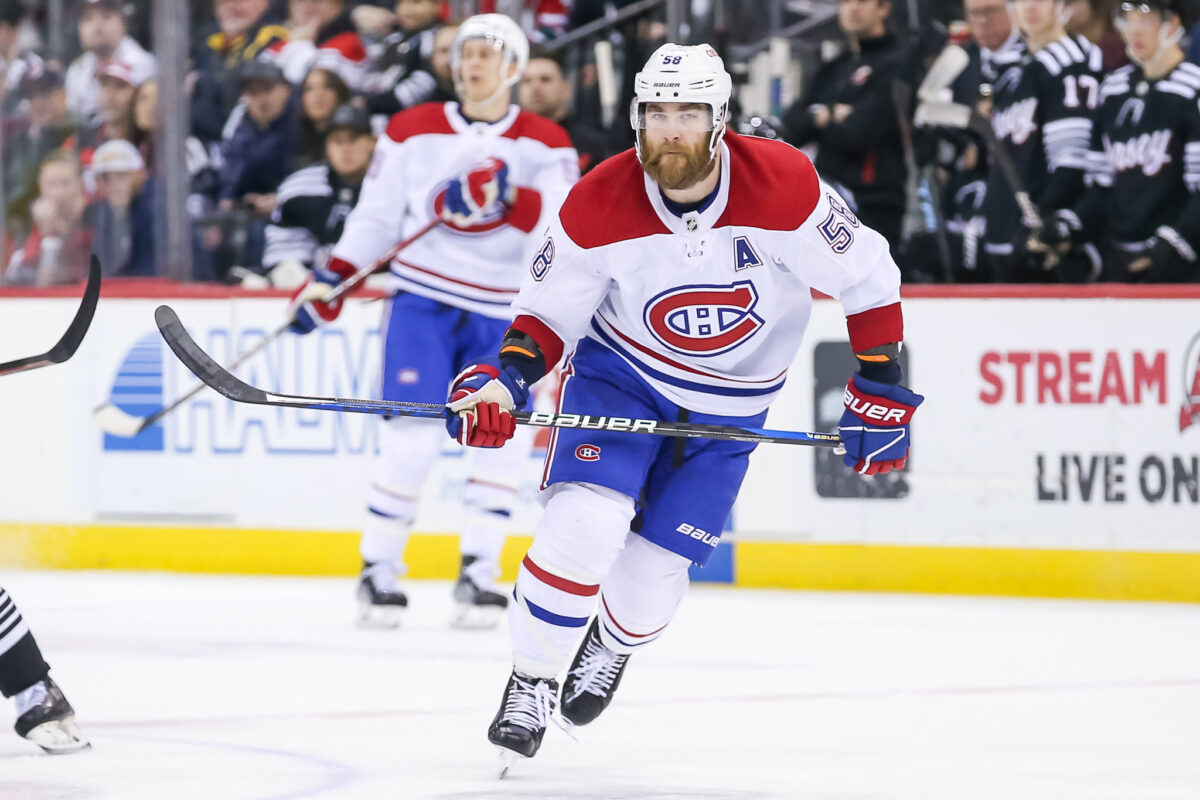To be clear: Montreal Canadiens prospect Lane Hutson does NOT make this list of the most overrated Habs entering 2024-25. As a 20-year-old who’s still a virtual unknown in terms of his ceiling, he should be far from fair game from criticism at this stage. However, that hasn’t stopped many vocal proponents from building him up to unattainable heights as a rookie, when he hasn’t even made it out of his first training camp, where he’s faced lesser competition.
Related: Canadiens Who Are the Most Overrated for 2023-24
Is Hutson a top prospect? Yes. Does he have the skills to quarterback a power play in the NHL? Yes. Does that make him a shoo-in for a roster spot and a Calder Memorial Trophy favourite, when his left side on defense is especially crowded and general manager Kent Hughes has gone on record as saying they won’t keep him up in the NHL just to become a power-play specialist? No, obviously.
You’d think, anyway.
Sure, Hutson can still make the team out of training camp. However, building him up to such an extent can be unhealthy for all parties involved. When so much is riding on his hopefully proper development, the Canadiens should exercise as much patience as needed, when he doesn’t absolutely need to make the NHL right away.
It’s a necessary preface to a controversial topic that’s been explored on these pages at around this time in past years. Just because someone is overrated, they’re not necessarily bad. It just means they’re not at the level of skill at which the vast majority of people see them. It also ISN’T a reflection of their contract. That’s another topic altogether. Instead, it’s an attempt to mitigate expectations around the following players, before they almost inevitably fall short in 2024-25:
3. Patrik Laine
With all that in mind, Patrik Laine makes for a logical entry on this list as someone who once scored 44 goals as a sophomore. He’s obviously also hurt currently, having suffered a serious injury this preseason, which will reportedly keep him out of action for 2-3 months. For that, he warrants warm wishes for a speedy return. However, that shouldn’t render him immune from acknowledgement he needs to be better than he has been in the recent past.
Now just 26, the Finn is still in his theoretical prime. However, he is coming off a season in which he scored just six times (nine points) in 18 games, before suffering a separate injury and spending time in the NHL/NHLPA Player Assistance Program.
The circumstances surrounding Laine’s departure from the Columbus Blue Jackets obviously speak to why he was available in the first place and how Hughes acquired him for so little. That probably won’t stop fans from assuming he’ll pick up where he left off the previous season as a point-per-game player, for all intents and purposes.
It’s possible Laine does, to be clear. However, everyone should focus more on how the trade was low-risk, in the event it doesn’t work out as hoped. It’s obviously high-reward in nature too, but that’s a reference to how it may end up a home run on Hughes’ part. He acquired Laine as someone who can put the puck in the net with great efficiency, not someone who for sure will.
Laine undeniably brings excitement, but he alone shouldn’t be what pushes the Canadiens over the top. The Habs finally staying healthy as a whole might. In that regard, things could have gone off to a slightly better start in the Laine era, which will realistically last only two seasons, before he becomes an unrestricted free agent. Fans may want to adjust expectations accordingly.
2. Christian Dvorak
Even after having lost the No. 2 centre role for which he was acquired to fill, Christian Dvorak remains in the team’s plans on Line 3, but arguably still above where he should be played (at least for the time being).

There is admittedly a degree of recency bias at work here. Dvorak is coming off a(nother) injury-plagued season in which he scored nine points in 30 games. His production has only decreased each season he’s played with the Canadiens, making a return to top-six status unlikely, even at Age 28.
Considering Dvorak’s near-the-bottom-of-the-lineup analytics (per MoneyPuck.com), it’s almost as if it’s purely his faceoff-taking ability that has kept him afloat where he is. However, with fellow-centre Jake Evans having exceeded the modest production expectations people on the outside looking in had for him last season (with a decent 52.2% success rate in the dot), he has arguably rendered Dvorak obsolete at a fraction of the cap hit ($1.7 vs. $4.45 million).
Now, Evans is a prototypical fourth-line centre who scored a decent 28 points in 82 games last season in part because of the injury situation and a need for him to play higher in the lineup. He’s not wowing the pants off anybody or at least he shouldn’t be. He does what is expected of him. So, any argument he should play higher in the lineup would be rooted more so in concern over Dvorak’s capabilities or lack thereof at this stage of the game.
In other words, Evans, who’s scored around 30 points before, hasn’t suddenly become a bona fide third-line center. Instead, Dvorak, who the Canadiens have had centering Josh Anderson and top-six-prospect Joshua Roy on the third line, maybe isn’t even an average third-line centre anymore.
1. David Savard
In a similar vein, David Savard isn’t a first-pairing defenseman… despite the fact he and the Habs’ top blue liner, Mike Matheson, formed the team’s most used one last season. In sharp contrast, immediately prior to signing with the Canadiens in 2021, he played the sixth-most amount of ice time on average among Tampa Bay Lightning defensemen during the team’s run to the Stanley Cup.
Considering the strengths of each club, the discrepancy is understandable, between the 14:07 he played those playoffs three years ago and his 20:14 per game last season, leading the Canadiens in average ice time while shorthanded (3:17)… on a team with a 76.5% penalty-kill success rate. It all serves as proof Savard is miscast in his current role, which, truth be told, can’t be considered all that Earth-shattering.
Just about everyone knows Savard isn’t a first-pairing defenseman, at least not in principle. In practice, it could be a different story, depending on how the pairings shake out, out of training camp. So, Savard’s place on this list is more so in response to widespread suggestions the pending UFA will earn the Canadiens a first-round pick. His actual value simply isn’t characteristic of what it should take to get a haul of that magnitude come the trade deadline… based on a slew of empirical evidence.
For example: the Detroit Red Wings dealt 28-year-old defenseman Jake Walman, who has two years left on his deal, AND a second-round pick to the San Jose Sharks for future considerations this summer. At the last trade deadline, the Sharks traded 31-year-old Radim Simek, a pending UFA, and a seventh-round pick to the Wings for Klim Kostin, who, while officially speaking is a former first-round pick, hasn’t exactly panned out as one might hope for the pick used to draft him.

On the subject of pending UFAs, the Philadelphia Flyers acquired Erik Johnson from the Buffalo Sabres for a fourth-round pick at that last trade deadline. Meanwhile, the Tampa Bay Lightning acquired Matt Dumba and a seventh-round pick from the Arizona Coyotes for a fifth. Probably the closest comparable in terms of age and playing styles, Chris Tanev went to the Dallas Stars for what amounted to a second-tier prospect (Artem Grushnikov) and a second-round pick, in a trade that was widely criticized for the Calgary Flames. Considering Savard is objectively a weaker than Tanev, Canadiens fans should brace for a lesser return.
Truth be told, fans don’t even need to look far for proof. Hughes traded a younger, physically imposing, yet-mobile and defensively sound defenseman in Johnathan Kovacevic, who is also a pending UFA, to the New Jersey Devils for a fourth-round pick this summer. Savard could be more attractive to teams gearing up for a playoff run based on his Stanley Cup experience, but, for the Canadiens’ rebuilding purposes, Kovacevic should have been seen as significantly more valuable… and Hughes dealt the latter, a fellow-right hander, instead. Maybe the Devils simply preferred Kovacevic, despite attempts on the Habs’ part to trade them Savard instead. However, that in and of itself would be a bad sign.
There’s no question, Savard is valuable from a leadership and defensive-awareness standpoint on such a young team. Still, he’s realistically on his way out at some point this season. There’s just no room for him on the team’s right side in the years to come. That means the value he holds is limited. When the Canadiens themselves shouldn’t want him past a certain point, they can’t expect other teams to just hand them a blank cheque. At that point, whatever they can get for him, so be it.
